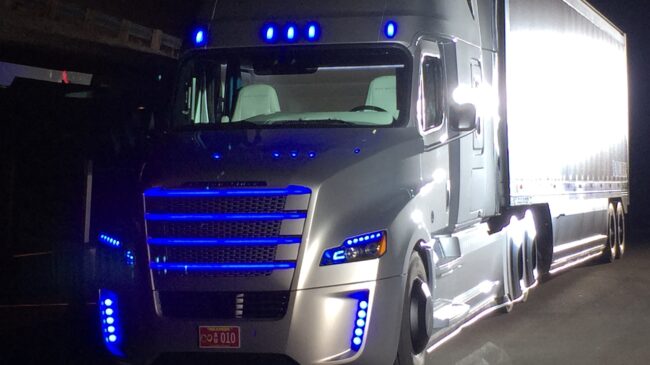On July 11, the California Senate Transportation Committee unanimously approved Assembly Bill 316. The bill would prohibit driverless trucks from operating in California, even for testing purposes. The Assembly already approved the bill on May 31 by a 69-4 vote. As A.B. 316 moves closer to the governor’s desk with a likely veto-proof majority behind it, the bill would cement California as the nation’s most burdensome regulatory environment for autonomous vehicles (AVs) and deny Californians the safety and mobility benefits these technologies bring to the table.
California was once at the forefront of innovative AV policy. Driven by Silicon Valley developers outside the traditional automotive industry, the AV industry in the U.S. remains concentrated in the Golden State—at least for now. Despite California’s ever-tightening regulatory environment, AV developers in the early days were optimistic about making progress in the state. California’s first AV bill, Senate Bill 1298, which created the state’s autonomous vehicles regulatory framework, was even signed into law by then-Gov. Jerry Brown at Google’s Mountain View headquarters in 2012. Fast forward a decade, and California’s AV policy has fallen behind states like Arizona, Arkansas, Florida, and Texas, which have avoided California’s onerous permitting approach to AV testing and deployment.
While the California Department of Motor Vehicles (DMV) has allowed AV testing and deployments to take place on public roads, these operations have been strictly limited by DMV regulations to vehicles weighing less than 10,001 pounds. This weight limit allows the testing and deploying of automated cars and some small cargo vehicles but excludes large trucks and buses from California’s AV permitting regime. On Jan. 27, the California DMV held its first workshop to consider updates to its AV testing and deployment rules to allow the testing of heavy-duty AVs.
In response to fuzzy concerns about truck drivers losing their jobs to autonomous vehicles, union-allied politicians introduced A.B. 316 the day before the DMV’s scheduled workshop. This bill would ban the testing and deployment of heavy-duty AVs without human drivers present in the vehicle. This would effectively kill the business case for AV trucking by preventing much of the potential cost savings. Over the long-term, enacting A.B. 316 would mean forgoing the safety and consumer benefits that AV trucks could offer, such as eliminating driver error that is responsible for the vast majority of crashes and greatly reducing truck operating costs.
After the bill was introduced, the Teamsters Union and California Labor Federation held a rally outside the state capitol in Sacramento with the bill’s sponsors. While framed as supporting safety, despite poor human decision-making being a factor in nearly all vehicle crashes today, attendees made clear they were really concerned about the potential for reductions in truck driver jobs—and dues-paying union drivers—that would arise from safer AVs. “Tech companies don’t talk about people. They don’t talk about families that depend on the jobs that you all rely on,” said the bill’s principal coauthor Assemblymember Ash Kalra.
Autonomous vehicle opposition organizers also made clear they believed if union-friendly California under single-party control couldn’t stop AV trucking, there would be no way to withstand the tide of transportation technology progress in the rest of the United States. “So goes California, so goes the rest of the nation. If we lose this, we’re never getting them back,” Teamsters Vice President Lindsay Dougherty told the crowd.
California does have an outsized influence on the national autonomous vehicles policy stage. Not only is it the largest state by population, but California is also home to the ports of Los Angeles and Long Beach, two of the largest container ports in the country. This makes Southern California an ideal near-term deployment candidate for short-haul automated drayage operations, as well as a hub for long-haul operations into the wider Sun Belt along Interstate 10.
But this dominance may be waning. Endless labor strife has snarled these ports, and international shippers are increasingly shifting their traffic to more productive ports to avoid California’s growing dysfunction. The World Bank’s most recent Container Port Performance Index of the world’s top 348 ports ranked Los Angeles at 336 and Long Beach at 346, in which productivity is measured by the time vessels spend in ports. In contrast, six eastern U.S. ports made it into the report’s top 100.
Rather than outlaw heavy-duty autonomous vehicles, California legislators should embrace innovation and allow regulators to set permitting requirements as they have for light-duty AVs. Properly designed safety regulations should be risk- and performance-based. In contrast, setting an arbitrary weight threshold merely reflects a superficial vehicle characteristic with little direct connection to safety. Further, hypothetical downstream economic considerations should have no role in safety regulation.
AV trucks are already on the road moving goods in other states. California’s politicians can either embrace market dynamism or resign themselves to stagnation. Being the home of so many leading technology companies largely delivered California’s AV leadership position a decade ago. But this advantage is unlikely to persist unless officials reject A.B. 316 and allow heavy-duty AVs to be safely integrated into California’s existing regulatory framework.

